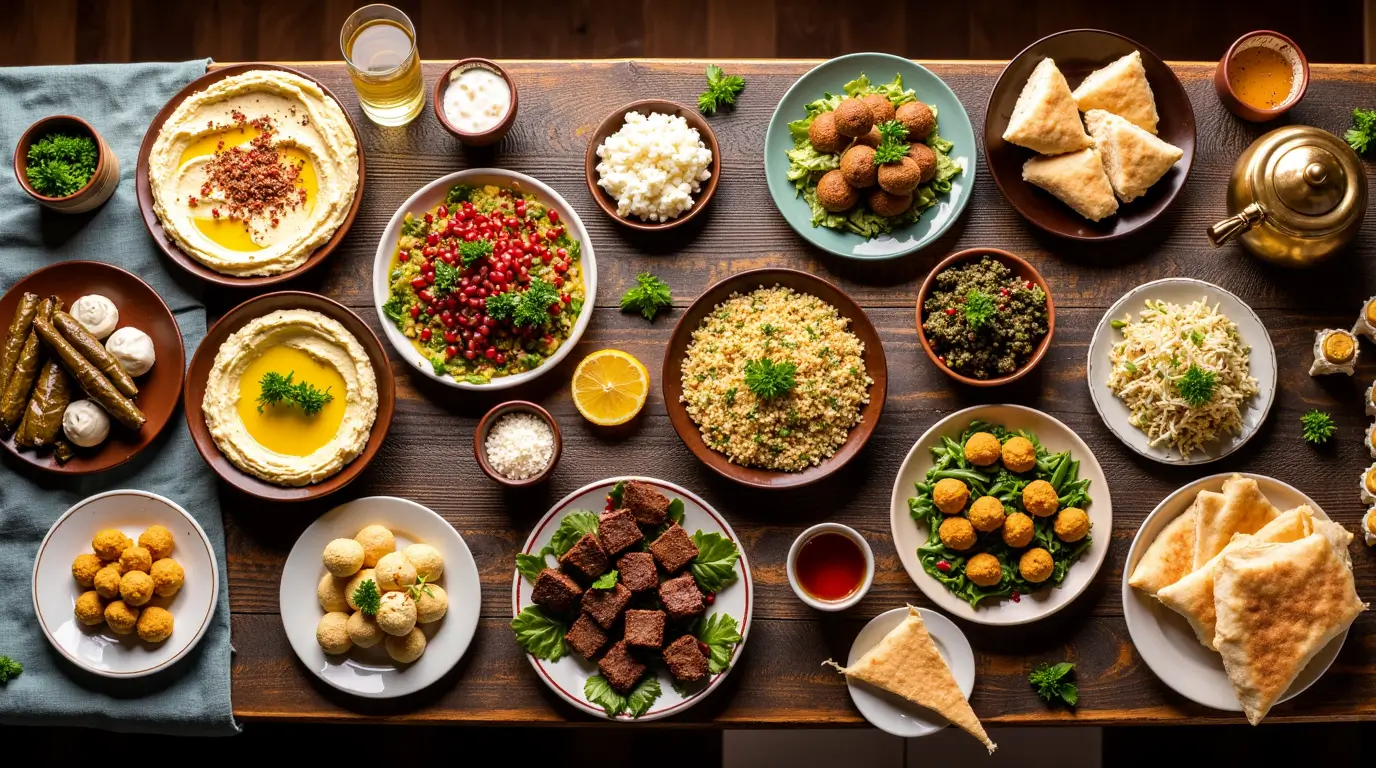Table of Contents
Table of Contents
Introduction
Lebanon, a small but vibrant country on the eastern coast of the Mediterranean, boasts one of the world’s most celebrated and beloved culinary traditions. Whether you’re drawn in by the tantalizing aroma of freshly baked bread, the bright flavors of lemons and olive oil, or the colorful, eye-catching meze spread that adorns family tables, Lebanese cuisine offers a tapestry of tastes that reflect the nation’s history, geography, and social fabric. Beyond the mouthwatering dishes themselves, Lebanese food culture also tells the story of a land that has functioned for centuries as a crossroads of trade routes, cultural exchanges, and political upheavals. This confluence of influences—Arab, Phoenician, Ottoman, French, and more—has forged a unique gastronomic identity that continues to delight food enthusiasts around the globe.
In this article, we will explore the many facets of Lebanese cuisine, delving into its historical origins, regional variations, and iconic dishes. We will also look at the ingredients that form the backbone of Lebanese cooking, including the flavorful herbs and spices that lend each dish its distinctive personality. For anyone who has savored a plate of hummus or a bowl of lentil soup and wondered about the stories behind these dishes, this deep dive into Lebanese culinary heritage is meant to spark your curiosity and inspire you to try making them at home. By the end, you will have not only a richer appreciation for Lebanese food but also a sense of how ancient traditions continue to evolve in the hands of modern chefs and passionate home cooks alike.
Culinary Context and History
Lebanese cuisine is, at its heart, a testament to the country’s layered history and diverse cultural encounters. Located at the crossroads of continents—between Europe, Asia, and Africa—Lebanon has, for millennia, been influenced by travelers, merchants, and conquerors. Its earliest recorded culinary identity can be traced back to the Phoenicians, the seafaring civilization that once inhabited the coastline of what is modern-day Lebanon. Known for their maritime trade, the Phoenicians brought back ingredients from across the Mediterranean basin, introducing a variety of grains, fruits, and spices that would become staples in the local diet.
Over the centuries, Lebanon fell under the rule of various empires, each of which left a distinct footprint on the local gastronomy. The Roman era saw the introduction of advanced agricultural techniques and new crops, while the Byzantine influence further cemented the region’s affinity for herbs and olive oil. The Arab conquest in the 7th century introduced rice, exotic spices, and new cooking methods, effectively shaping the region’s use of fragrant ingredients like cinnamon, cumin, and allspice. Centuries later, Ottoman rule ushered in a golden era for Levantine cuisine, fostering the growth of coffee culture and sweet pastries like baklava, as well as meze-style dining, which has become synonymous with Lebanese hospitality.
In the early 20th century, Lebanon experienced French colonial rule, leaving a noticeable imprint on its baking and pastry traditions. French techniques melded seamlessly with local methods, and to this day, Lebanese bakeries feature croissants and French baguettes alongside manakish and saj bread. This amalgam of influences—Phoenician maritime trades, Ottoman cooking traditions, and French culinary finesse—lies at the foundation of contemporary Lebanese cuisine. It is a tapestry of international flavors united by Lebanon’s fertile soil, Mediterranean climate, and a deep respect for fresh, high-quality ingredients.
Major Events and Key Periods
Political and social upheavals have also played a role in shaping the national palate. Periods of conflict and migration brought waves of Lebanese expatriates to various corners of the globe, particularly the Americas, Africa, and Australia. These diaspora communities maintained strong ties to their home country’s food traditions, exporting a taste for dishes like tabbouleh, kibbeh, and shawarma. Over time, Lebanese cuisine has become a fixture in many international food scenes, from the Middle East to Europe and beyond, with restaurants and street-food stalls serving up meze platters and grilled skewers to curious diners worldwide.
Regional Differences
While Lebanon is geographically small, there are subtle but important distinctions in flavor profiles and culinary preferences across its regions. In the north, cities like Tripoli are famed for their rich dessert culture, featuring confections such as knafeh (a sweet cheese pastry soaked in syrup) and halawet el-jibn (sweet cheese rolls). The north also benefits from coastal fishing, offering abundant seafood dishes that are typically grilled or baked in clay ovens.
In the southern regions, particularly around the city of Saida (Sidon) and Tyre, fresh fish and shrimp play a significant role. Local cooks often use tangy citrus-based marinades, combining lemon juice, garlic, and olive oil in a way that brightens fish dishes and meze salads. Moving inland, mountainous areas place a heavier emphasis on hearty fare, drawing upon goat dairy products, lentils, beans, and bulgur wheat to produce comforting stews and soups ideal for cold winters.
The Bekaa Valley in eastern Lebanon is considered the country’s agricultural heartland, known for vineyards that produce celebrated Lebanese wines as well as expansive fields of vegetables, fruits, and grains. Each region’s reliance on specific local products and time-honored recipes creates a mosaic of culinary expressions that collectively form the national identity. At the same time, all Lebanese households hold fast to certain constants—warm hospitality, a penchant for fresh produce, and the liberal use of garlic and lemon juice—that define the flavor and spirit of the cuisine.
Key Ingredients and Local Products
At the core of Lebanese cooking lies a respect for quality, fresh ingredients that are typically sourced from local markets and, increasingly, from small organic farms. Many dishes revolve around the skillful blending of vegetables, grains, and legumes with herbs, spices, and modest amounts of meat or fish. These ingredients come together to create vibrant, balanced plates that are as visually appealing as they are delicious.
Spices, Herbs, and Seasonings
Lebanese cooks rely heavily on a few key spices to achieve the warm and aromatic notes typical of the cuisine. Cinnamon, allspice, sumac, and cumin are used in everything from meat marinades to stews and even rice dishes. Sumac, a tangy red powder ground from dried sumac berries, is particularly emblematic; it replaces lemon juice in certain salads and can be sprinkled on grilled meats to add a citrusy spark. Za’atar—an herbal blend of thyme, oregano, sumac, and sesame seeds—deserves special mention. Commonly mixed with olive oil and spread on bread dough to make manakish, za’atar embodies the distinct earthiness that many associate with Lebanese flavor profiles.
Fresh herbs also have a starring role. Parsley, mint, cilantro, and dill are found in everything from tabbouleh to various dressings and marinades. The iconic tabbouleh, for instance, is more herb salad than grain salad, built on mountains of finely chopped parsley and mint. Garlic and onions are ever-present aromatics, often pounded into a paste with salt or minced into sauces for an added layer of flavor.
Grains, Legumes, and Vegetables
Bulgur wheat is central to many beloved Lebanese dishes, including kibbeh (ground meat mixed with bulgur) and tabbouleh. It adds a nutty taste and chewy texture that pairs well with fresh herbs, meats, or vegetables. Rice also figures prominently, particularly in stuffed vegetable dishes such as mehshi (stuffed zucchini, eggplants, or grape leaves). Lentils, chickpeas, and fava beans serve as the protein foundation for many vegetarian meals, which are abundant in Lebanese cuisine due to religious fasting traditions and the availability of quality legumes.
Lebanon’s fertile soil and Mediterranean climate yield an impressive variety of vegetables: tomatoes, cucumbers, eggplants, zucchinis, peppers, and leafy greens are just a few staples you’ll encounter. These vegetables aren’t merely side dishes; they often take center stage, stuffed with fragrant rice mixtures or stewed in rich tomato sauces that showcase the region’s preference for bright, tangy flavors.
Meats, Fish, and Dairy
Although Lebanese cuisine is often associated with lamb, chicken is equally popular, and beef also finds its way into many preparations. Thanks to its lengthy coastline, Lebanon has a robust seafood tradition, with fish, shrimp, and squid appearing on coastal menus. Dairy products derived from goats and cows—like labneh (a thick yogurt) and various white cheeses—add a creamy, tangy contrast to dishes and are used frequently for dips, spreads, or dessert fillings.
Seasonality and Its Impact
Traditional Lebanese cooking is profoundly influenced by the seasons. Many of the country’s signature dishes—like fattoush (a bread salad with vegetables and herbs)—are vibrant celebrations of freshly harvested produce. Winter dishes often lean toward hearty soups and slow-cooked stews, such as lentil soup with Swiss chard or thick chickpea soups seasoned with cumin and lemon. In the summer, tables overflow with colorful vegetable salads, grilled meats, and chilled yogurt drinks flavored with cucumber and mint. This focus on seasonality means that the quality and freshness of ingredients are paramount, which is one reason Lebanese markets are renowned for their abundant displays of just-harvested fruits and vegetables.
Buying Tips
If you’re interested in recreating Lebanese dishes at home, try to source the freshest herbs and vegetables possible. Specialty Middle Eastern grocery stores or well-stocked international sections of supermarkets often carry sumac, za’atar, bulgur, and labneh. Online retailers also offer a wide range of Lebanese products if local shops are not an option. Whenever possible, choose high-quality olive oil and fresh produce that will bring out the best flavors in your homemade creations.
Must-Try Traditional Dishes
Lebanese cuisine is characterized by a variety of dishes that showcase the country’s diverse influences and love for communal eating. While the list of must-try dishes could fill a book, the following are a handful of iconic plates that illustrate the essence of Lebanese gastronomy.
Tabbouleh
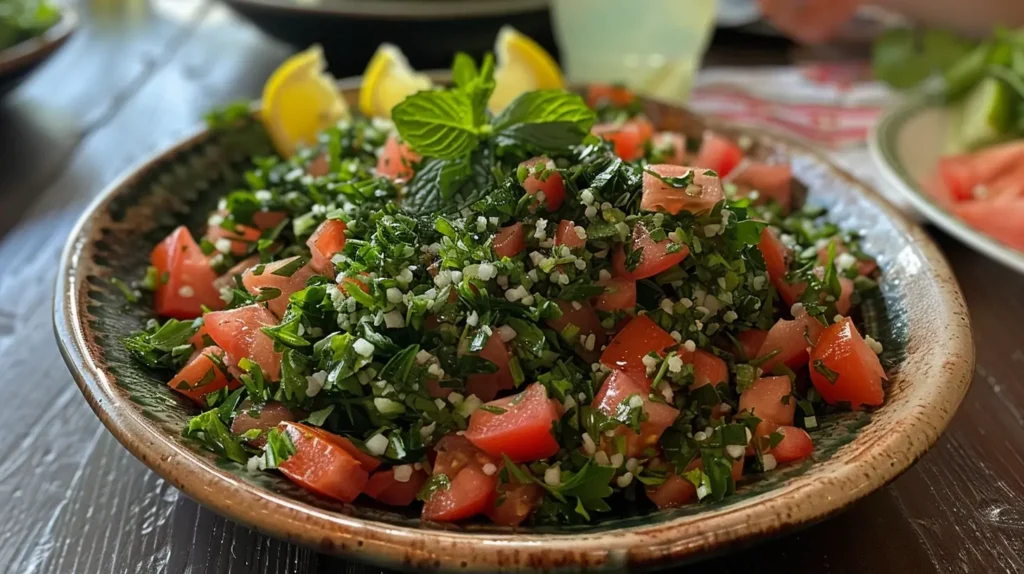
History and Characteristics:
Originating in the mountains of the Levant, tabbouleh began as a reflection of rural communities’ reliance on parsley, bulgur, and mint. Today, it is a globally recognized dish that epitomizes freshness and balance. Typically served as part of a meze spread, tabbouleh is a parsley-based salad that includes bulgur wheat, chopped tomatoes, fresh mint, finely diced onions or scallions, and a dressing of lemon juice and olive oil. The result is a tangy, bright side dish that can also stand alone as a light meal.
Simple Recipe (Serves 4):
- Rinse and soak ½ cup fine bulgur in warm water for about 20 minutes, then drain.
- Finely chop 2 bunches of fresh parsley, 1 handful of fresh mint, and 2 medium tomatoes.
- Combine parsley, mint, tomatoes, and drained bulgur in a large bowl.
- In a small bowl, whisk together the juice of 2 lemons, 3 tablespoons olive oil, and salt to taste.
- Pour the dressing over the salad and mix thoroughly. Let it rest for 10 minutes before serving.
Regional Variations:
Some regions add a pinch of allspice or cinnamon to the dressing, while others vary the proportion of bulgur to herbs. In certain villages, people add cucumber or pomegranate seeds for extra crunch or sweetness.
Kibbeh
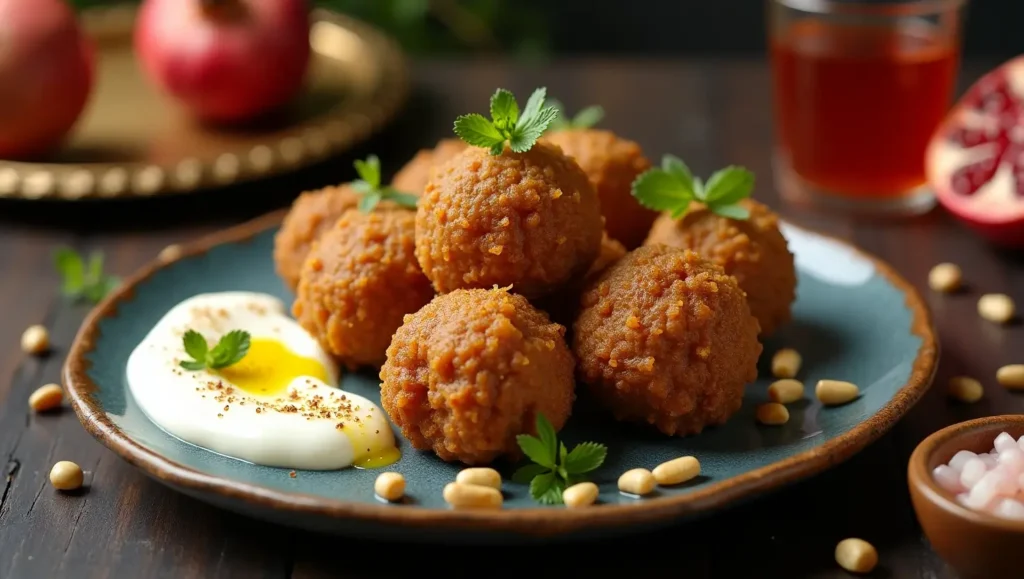
History and Characteristics:
Kibbeh is often referred to as Lebanon’s national dish. Ground meat (commonly lamb or beef) is mixed with bulgur, onions, and spices to form a paste-like mixture. It can be molded into balls or patties and either baked, fried, or eaten raw (kibbeh nayeh). The dish’s popularity dates back centuries, owing to its filling nature and the relatively low cost of bulgur compared to meat. Kibbeh’s distinctive taste lies in the blend of spices—especially cinnamon, allspice, and a touch of cumin—and the contrasting textures of crispy crust and moist filling.
Simplified Recipe (Fried Kibbeh, Serves 4–6):
- Rinse and soak 1 cup fine bulgur for about 15 minutes, then drain thoroughly.
- In a food processor, blend 1 pound ground beef or lamb, ½ cup finely chopped onion, drained bulgur, 1 teaspoon salt, and 1 teaspoon allspice until well combined.
- Prepare the filling by sautéing another ½ pound ground meat with chopped onions, pine nuts, and spices (salt, pepper, allspice) in olive oil until browned.
- Take small portions of the kibbeh dough, form balls, and make a hole in the center for the filling. Add a teaspoon of the sautéed meat mixture, then seal.
- Fry the kibbeh balls in hot oil until golden brown. Drain on paper towels and serve warm with yogurt or tahini sauce.
Regional Variations:
In coastal areas, fish kibbeh or vegetarian kibbeh made with pumpkin (kibbeh lakteen) is common. Kibbeh nayeh is another beloved variant, especially in mountainous regions, where the quality of fresh lamb is highly prized.
Hummus and Baba Ghanoush
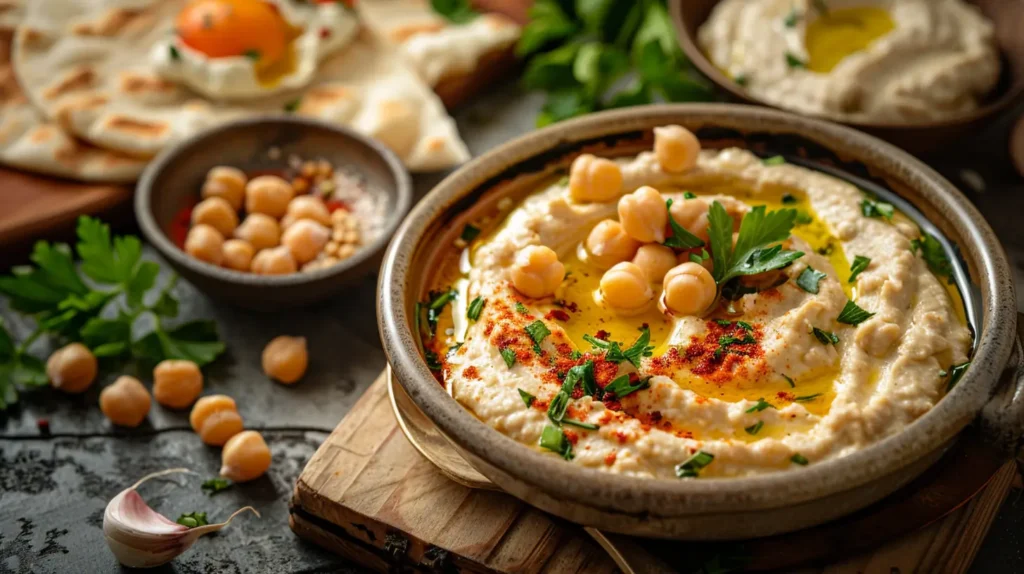
History and Characteristics:
These iconic spreads have become household names worldwide. Hummus—made from chickpeas, tahini (sesame paste), lemon juice, and garlic—has roots that trace back to medieval Arab cookbooks. Baba ghanoush, on the other hand, highlights the smoky flavor of roasted eggplants blended with tahini, garlic, and sometimes yogurt. Both are often served with a drizzle of olive oil and a sprinkle of paprika or fresh parsley. They are essential components of any Lebanese meze feast.
Tips for Making Them at Home:
- For extra creamy hummus, peel the chickpeas or use canned chickpeas heated in water and baking soda before blending.
- Roast or grill the eggplants for baba ghanoush until their skin is charred and the flesh is soft, which imparts a wonderfully smoky taste.
- Adjust the balance of tahini and lemon juice to suit your palate; some like it tangier, while others prefer a richer sesame flavor.
Manakish
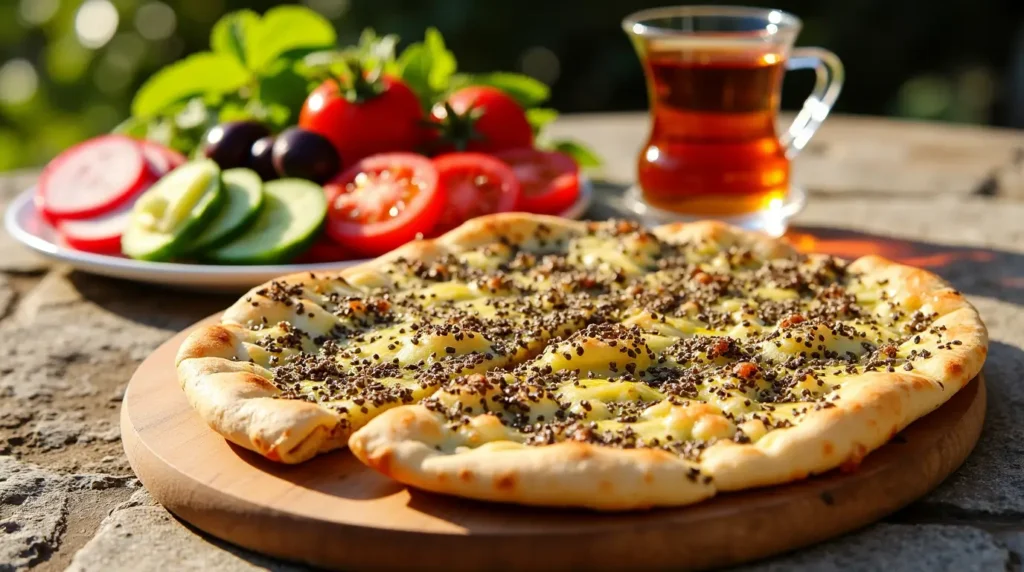
History and Characteristics:
Often described as the Lebanese version of pizza, manakish is flatbread topped with za’atar and olive oil, cheese, or minced meat. It is a go-to breakfast or brunch item, enjoyed by families all across the country. The dough is rolled out, spread with the desired topping, and then baked in a traditional oven or modern oven at high temperature.
Regional Variations:
While za’atar manakish is the most classic variety, other common toppings include fresh white cheese (like akkawi), labneh with olives, or a mixture of ground meat, onions, and pine nuts known as lahm bi ajin. In some regions, manakish is served folded and wrapped in paper for a quick, on-the-go snack; elsewhere, it’s sliced into wedges, ideal for sharing.
Defining Characteristics of Lebanese Cuisine
Lebanese food is often celebrated for its freshness, vibrant flavors, and a culinary balance that emphasizes herbs, citrus, and olive oil. While it isn’t generally described as extremely spicy in the sense of chili heat, it does rely on aromatic spices such as cinnamon, allspice, and cumin to build depth. The taste profile is often tangy—lemon juice, pomegranate molasses, and sumac are frequently used to bring sharpness to a dish—and accented by the earthy warmth of garlic. Sweetness, when it appears, usually emerges in desserts or fruit-based syrups rather than seeping into savory dishes.
Seasonings or flavor combinations that are quintessentially Lebanese include garlic, lemon, and olive oil—a trio used to marinate meats, dress salads, and amplify the inherent flavors of grilled or raw vegetables. Another hallmark is the liberal use of fresh herbs like parsley and mint, which keep dishes tasting lively and clean. These elements appeal to food enthusiasts who crave bright, layered tastes without an over-reliance on heavy sauces or fats. For those seeking to explore new palettes, Lebanese cuisine offers a gentle introduction to Middle Eastern flavors, with just enough spice and tang to pique the palate without overwhelming it.
Tips and Highlights to Encourage People to Try this Cuisine
One of the most compelling reasons to delve into Lebanese food is the social aspect that underpins every meal. Whether you’re sharing a meze spread or preparing a slow-cooked feast for a holiday, Lebanese cuisine fosters connection and conversation. Imagine sitting around a bustling table, plucking warm bread off a communal plate and dipping it into an array of shared bowls—this kind of conviviality is at the heart of the Lebanese dining experience.
Another allure is the cuisine’s emphasis on seasonal and wholesome ingredients. For health-conscious eaters, Lebanese dishes often contain moderate amounts of meat, favor plant-based proteins, and showcase a variety of nutrient-rich vegetables and fruits. If you are an adventurous cook, there’s also a wide avenue for experimentation: once you have the basic building blocks—like garlic, lemon, sumac, za’atar, and tahini—you can mix and match them in countless creative ways. Between the history, the communal spirit, and the fresh, vibrant flavors, Lebanese cuisine is a captivating tapestry that begs exploration.
Table Rituals and Customs
In Lebanon, meals are not merely about satiating hunger; they are social and cultural events. Hosting guests is a point of pride, and households go to great lengths to present a variety of dishes, ensuring everyone leaves satisfied. The typical Lebanese day begins with a simple breakfast—possibly manakish or a light spread of labneh, olives, and fresh bread. Lunch is often the main meal, traditionally eaten in the early afternoon. Families might gather around a table laden with multiple courses: salads like fattoush or tabbouleh, hot and cold meze dishes such as hummus and fried kibbeh, followed by grilled meats or stews.
Dinner is usually lighter and served later in the evening, often around 8 or 9 p.m. In urban areas, especially in Beirut, dining out at restaurants offering international cuisines or modern spins on Lebanese classics has become a norm. Weekends or special occasions can see more elaborate feasts that may begin with an aperitif of arak (an anise-flavored spirit) and small snacks, followed by an extended meze course, and concluded with sweets, fruits, and coffee.
Table Etiquette
Lebanese dining etiquette emphasizes sharing and generosity. It is common courtesy to offer dishes around the table, encouraging others to try each plate. Using bread to scoop food is acceptable, and many Lebanese people prefer to eat some meze dishes with their hands rather than utensils. However, it’s important to avoid using the left hand for communal plates, as that may be considered unhygienic by some. If you are a guest in a Lebanese home, you can expect the host to insist that you try every dish, often refilling your plate even after you’ve said you’re full. Politely sampling each dish is a sign of respect and appreciation.
National Holidays, Religious Events, and Celebrations
Lebanon’s population is incredibly diverse in terms of religious affiliations, leading to a calendar rich with holidays that feature their own culinary traditions. For Muslim families celebrating Ramadan, evenings break the fast with dates, lentil soup, and a host of special pastries like qatayef. Christian families, particularly those belonging to the Maronite, Greek Orthodox, or other Eastern churches, observe Lent by preparing vegetarian or vegan dishes like mujaddara (lentil and rice stew) or falafel. Major Christian feasts such as Easter see the baking of maamoul (date- or nut-filled cookies) dusted in powdered sugar. Meanwhile, family celebrations like weddings and baptisms are lavish affairs where huge meze spreads and multi-course meals are served to mark the occasion. These holidays and events reveal how food in Lebanon is closely tied to faith, tradition, and the celebration of life’s milestones.
Modern Trends and Culinary Fusions
Lebanese cuisine, while deeply rooted in tradition, has proven remarkably adaptable to contemporary trends and global influences. Over the past few decades, fusion cuisine has become increasingly visible in Beirut’s upscale restaurants, where chefs experiment with international elements—incorporating, for instance, Japanese seafood techniques into local fish dishes or blending Italian pasta with Levantine sauces. Such experimentation resonates with younger generations who are open to globally inspired menus but still value the comfort and authenticity of their heritage foods.
New Consumption Trends
Just as the country’s diaspora carried Lebanese food across the globe, returning travelers and modern digital platforms continue to import culinary ideas from abroad. In major cities, you can now find vegetarian and vegan takes on classic dishes. For instance, kibbeh can be made with pumpkin, lentils, or potatoes in lieu of meat. The rise of farm-to-table concepts has encouraged local sourcing and organic produce, reflecting a growing awareness of health and environmental sustainability. Chefs who champion these causes often promote a return to ancestral farming practices, chemical-free crops, and small-scale production of specialty foods like artisanal cheeses or heirloom varieties of wheat.
Young Chefs and Restaurateurs
In contemporary Lebanon, a new wave of chefs and restaurateurs is reviving heritage dishes in modern ways. Influential culinary figures might keep the essence of a family recipe—like stewed okra with tomatoes and garlic—but present it in a refined plating more akin to fine dining. Restaurant interiors also mirror this blend of old and new, merging traditional Lebanese decor (mosaic tiles, brass lanterns) with sleek modern furniture. These chefs often see themselves as cultural ambassadors, bridging the gap between old-world cooking and modern gastronomic expectations. Their work ensures that Lebanese cuisine remains vibrant and relevant, attracting both local patrons and international food tourists who eagerly line up to sample these creative reinventions.
Conclusion and Call to Action
Lebanese cuisine stands out as a culinary tradition that beautifully merges ancient influences, diverse regional nuances, and modern twists. In this exploration, we have traced how Lebanon’s geographic position and history—shaped by Phoenicians, Romans, Ottomans, and the French—contributed to a rich gastronomic identity. We have delved into regional distinctions, from the dessert culture of Tripoli to the seafood traditions of the southern coast and the hearty mountain fare of the country’s highlands. We have highlighted key ingredients such as sumac, za’atar, bulgur, and fresh herbs, which together form the backbone of many iconic dishes. We explored must-try fare like tabbouleh, kibbeh, hummus, and manakish, each offering a different lens through which to appreciate Lebanon’s layered flavors and communal spirit. We also touched on defining characteristics—like a love for tangy, bright tastes—and the table rituals that reinforce hospitality and sociability.
Moreover, we learned about modern trends shaping the evolution of Lebanese cuisine: fusion experiments, farm-to-table approaches, and the younger generation’s reinterpretation of time-honored recipes. This synthesis of traditional techniques and novel ideas ensures that Lebanese gastronomy continues to grow and capture imaginations beyond its homeland. Whether you are a seasoned foodie or a curious beginner, there are countless ways to engage with Lebanese cuisine—be it through experimenting in your own kitchen, visiting local Lebanese restaurants, or seeking out specialty markets to find spices like sumac and za’atar.
As a parting thought, consider exploring Lebanese pastries and desserts in a future culinary adventure. Confections like baklava, maamoul, and knafeh are steeped in fascinating histories of their own, and each sweet bite offers a glimpse into the cultural tapestry of the Levant. In the meantime, we invite you to share your own experiences with Lebanese cooking: Which dish have you tried? Which ingredient has intrigued you the most? Have you discovered a new favorite flavor combination? Don’t hesitate to ask questions or compare notes on techniques and recipes. There is always more to discover in the world of Lebanese cuisine, and your kitchen might just be the perfect place to continue that journey.
By exploring, tasting, and sharing, you become part of a tradition that prizes community, hospitality, and fresh flavors—a tradition that speaks not only to the stomach but also to the heart. So roll up your sleeves, gather your fresh produce, and dust off your spice jars. The warmth and zest of Lebanese cuisine await you, ready to transform your table into a place of celebration and cultural exchange. Bon appétit—or, as the Lebanese say, Sahtein!

